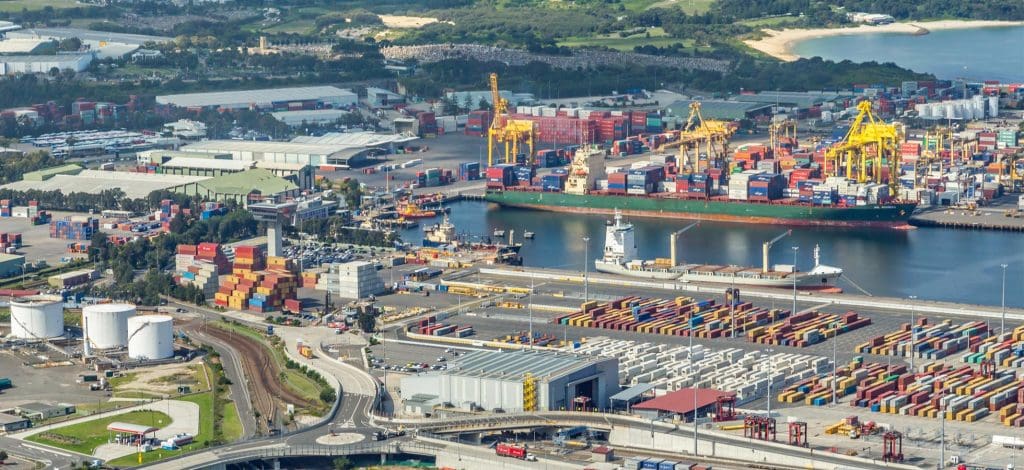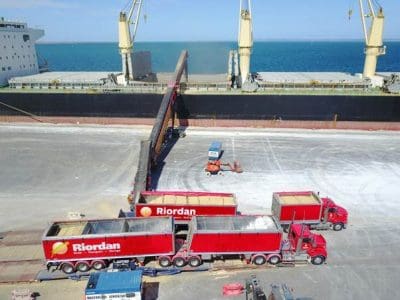
Port Botany in Sydney is a major export point for containerised grain, meat and cotton produced in NSW. Photo: NSW Ports
AUSTRALIA’S first national grains industry logistics conference will give an insight into the challenges and opportunities facing bulk and containerised grain movement in a changing supply chain.
The brainchild of Grain Trade Australia’s Transport, Storage and Ports Committee, the event is titled Evolving and Innovating the Grain Supply Chain, and is being held on 9-10 April in Melbourne.
“We’re giving our members and interested parties the chance to hear from some of the major participants and innovators in the grain supply chain in the midst of some big changes,” GTA CEO Pat O’Shannassy said.
They include the challenges of drought-driven redeployment of eastern Australian ports from points of bulk export to receivers of interstate grain, and the current and future use of alternative mobile ship-loading options.

Riordan Grain Services loads a vessel at the Port of Geelong. Photo: Riordan Grain Services.
These are being used by a number of exporters and new entrants in the field of portside bulk-handling, including Riordan Grain Services, and general manager Mark Lewis will be addressing the conference on the topic.
Representatives from Newcastle Agri Terminal, Quattro at Port Kembla, and T-Ports, with a seaport transhipment site now under construction on the Eyre Peninsula, will also share their perspectives.
Container Transport Alliance Australia (CTAA) director Neil Chambers will be looking at the landside logistics issues that contribute to added costs in the supply chain for exporters of containerised grain.
Container mismatch
Mr Chambers said the oversupply of 40-foot hi-cube containers coming into Australia with imports versus the shortage of available 20-foot food-grade containers was a continuing trend to watch.
“From a grain exporters’ point of view, this mismatch is a factor in the lack of timely availability of suitable empty containers for export commodity-packing during peak times.”
“Australia’s biggest containerised export is fresh air, as 40-foot containers aren’t suitable for many agricultural export commodities, and this means shipping lines are required to import empty 20-foot containers to meet food-grade export needs.”
“That’s something we have to be ready for.”
Food-grade standard needed
Mr Chambers said GTA was leading a discussion within the grain industry about what constituted a food-grade container.
“Some subjective interpretations of the standards have meant that authorised officers will sometimes containers as unsuitable when they get to the up-country packer.”
“We need a better set of guidelines, and we need to work at better forecasting the amount of containers we will need, or we will suffer through them not being available when we need them.”
Mr Chambers said grain exporters needed to minimise their logistics costs, because rising cost pressures in Australian landside supply chains can be the difference between a profit or loss on the export of a container of grain.
“We have competition from plenty of other countries, including Brazil and Argentina, and our freight rates are going to rise, because of the consolidation of the international container-shipping lines, and the higher international shipping rates and added charges that this consolidation will likely bring.”
“This conference will give us a chance to look at how we can be more competitive.”
Mr Chambers said the world’s 10 largest shipping lines now carried 87 per cent of the world’s 20-foot equivalent (TEU) movements, compared with the mid-1990s figure of the top 20 lines carrying 48pc.
“There’s been considerable consolidation in the past five or six years, and they haven’t stopped yet.”
“Our freight rates will head north, so we’ve got to get smarter and leaner and meaner.”
Mr Chambers said a ballpark freight-rate figure to ship a 20-foot container of grain to Southeast Asia was around $400-$500, which was around half the cost of getting it from country New South Wales to Port Botany.
“What we need to keep in mind is that every time you handle a container in the landside logistics chain, it adds $30-$50 to the costs.
“Minimising unnecessary handling, and streamlining supply chains must be the goal to stay competitive.”
Big picture
Other speakers at the GTA Australian Grains Industry Logistics conference include:
- Qube managing director Maurice James;
- Kotzur Pty Ltd managing director Andrew Kotzur;
- Kelly Grains general manager Matt Kelly;
- Boolah Commodity Management principal Stuart Tighe;
- Ridley general manager merchandising and nutrition Michael Reeves;
- Wilson International Trade CEO Peter Wilson.
View the full program here.



HAVE YOUR SAY